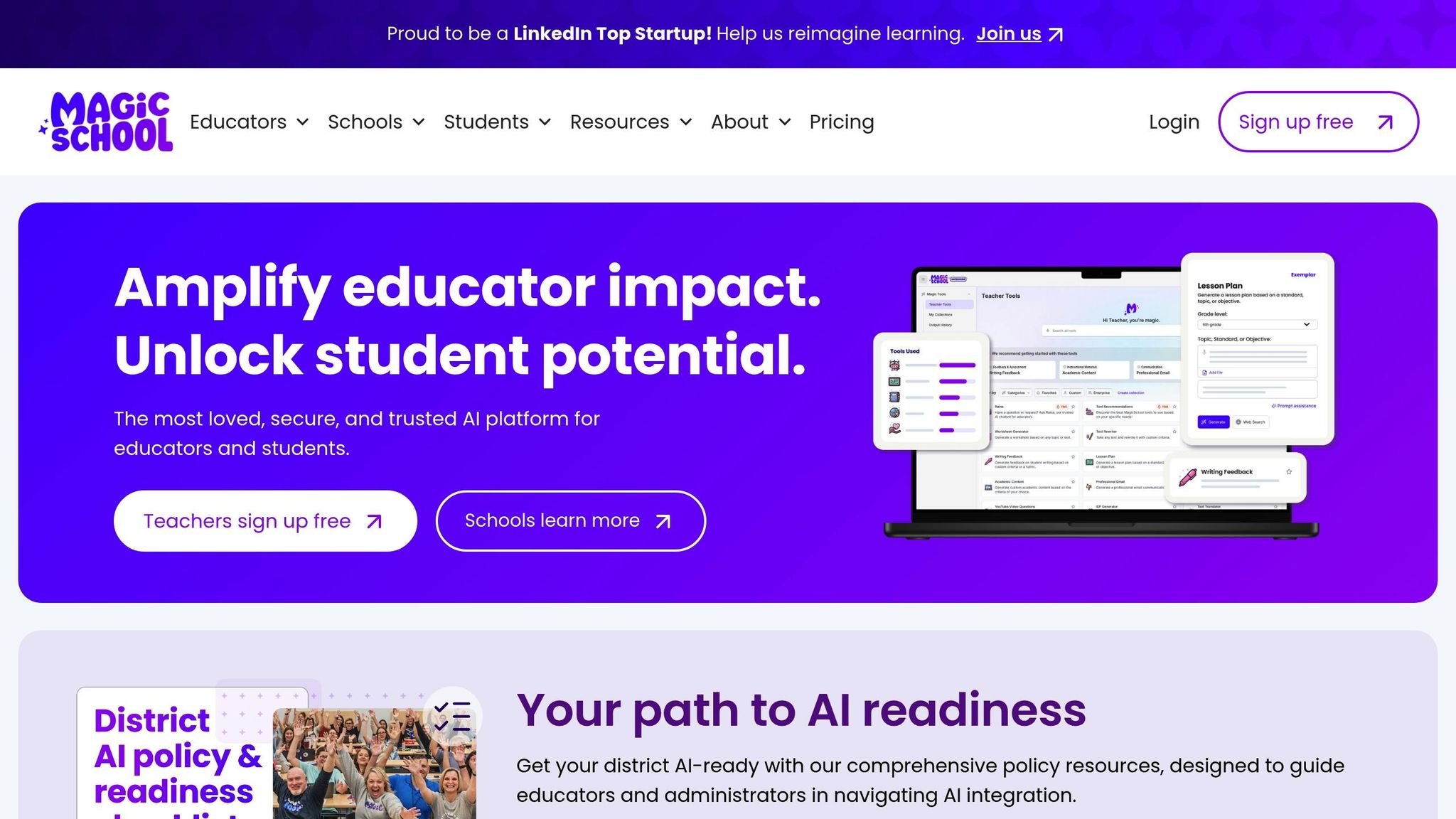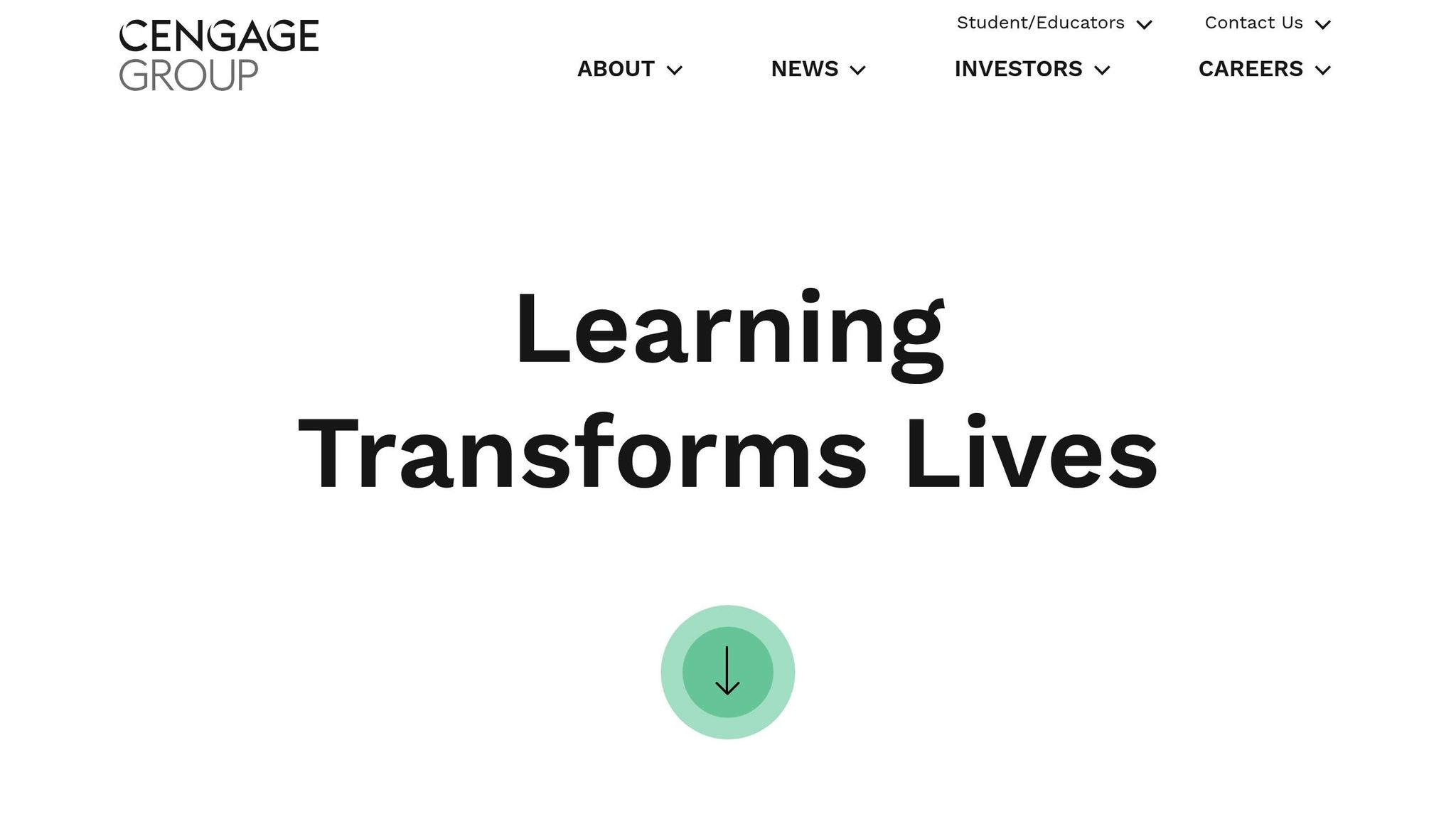AI tools are transforming how teachers manage their classrooms, save time, and improve student outcomes. In November 2025, five standout platforms are helping educators handle lesson planning, grading, and personalized learning more effectively. Here's a quick look:
- MagicSchool.ai: Streamlines lesson planning, grading, and student feedback while ensuring privacy compliance. Free for individuals; schools can opt for enterprise plans.
- Eduaide.AI: A simple tool for creating classroom materials and personalizing lessons. Plans start at $0/month, with a Pro option at $5.99/month.
- PowerBuddy (by PowerSchool): Focuses on grading and adaptive learning, ideal for schools using PowerSchool systems.
- AI-Powered Insights Dashboard (Cengage Group): Offers data-driven insights for better classroom decisions.
- AI Content Leveler (Cengage Group): Adjusts materials to suit different reading levels, supporting diverse learners.
These tools cater to different needs, from reducing admin tasks to tailoring lessons for individual students. Below is a comparison to help you decide which tool fits your classroom best.
Quick Comparison
| Tool | Key Features | Pricing | Best For |
|---|---|---|---|
| MagicSchool.ai | Lesson planning, grading, admin tasks | Free/basic; custom for schools | All-in-one teaching assistant |
| Eduaide.AI | Quick content creation, personalized tools | $0-$5.99/month | Teachers needing simplicity |
| PowerBuddy | Smart grading, adaptive learning | School-specific | PowerSchool users |
| Insights Dashboard | Data insights for performance tracking | Not disclosed | Data-driven decisions |
| Content Leveler | Adjusts materials for varied reading levels | Not disclosed | Supporting diverse learners |
Each tool offers unique benefits tailored to specific challenges. Test free versions to see how they align with your teaching style. Always prioritize privacy and review AI-generated content for accuracy.
Top 5 AI Tools for Teachers: Save 200+ Hours on Lesson Planning in 2025
1. MagicSchool.ai

MagicSchool.ai has become a cornerstone in U.S. education, reaching millions of teachers across nearly every school district. It’s designed to lighten the administrative load for educators while improving outcomes for students.
Simplifying Lesson Planning
With MagicSchool.ai, lesson planning becomes a breeze. The platform generates standards-aligned lesson plans and academic materials in just minutes. Its suite of over 80 teacher tools can save educators 7–10 hours of planning each week.
Comprehensive Assessments Made Easy
Creating assessments is another area where MagicSchool.ai shines. The platform produces quizzes, tests, and rubrics that align perfectly with lesson objectives, giving teachers the tools they need to effectively measure student progress.
Tailored Learning for Every Student
MagicSchool.ai is also a powerful ally in personalized education. It helps teachers create individualized IEPs and adapt lesson plans to different reading levels and specific student needs. This ensures that every learner gets the support they require to succeed. Beyond teaching, the platform also streamlines administrative processes.
Boosting Communication and Efficiency
The platform doesn’t stop at lesson planning - it also automates routine tasks like emails, progress reports, and conference notes, freeing up even more time for educators.
Built-In Security and Seamless Integration
Security is a top priority for MagicSchool.ai, which boasts a 93% privacy rating and offers custom data agreements for districts. It has earned the ESSA Badge IV, verifying its compliance with the Every Student Succeeds Act. Plus, it integrates effortlessly with widely used LMS platforms like Google Classroom, Canvas, and Schoology, and supports one-click exports to Google Docs and Microsoft Word.
Flexible Pricing Options
MagicSchool.ai offers free access to core features for individual educators and students. For schools and districts, an enterprise solution provides advanced customization options, administrative controls, and enhanced security. Pricing for institutions is available through direct consultation.
"The go-to AI assistant for educators worldwide, designed to simplify teaching tasks, save time, and combat teacher burnout."
- MagicSchool.ai
2. Eduaide.AI
Eduaide.AI is a budget-friendly AI tool designed to simplify lesson planning and content creation for teachers. It’s accessible for all educators, regardless of their tech expertise, and helps streamline the planning process, allowing for more personalization and efficiency in the classroom.
Effortless Lesson Planning in Three Steps
Creating classroom materials is as simple as:
- Choosing a resource type.
- Entering your topic using keywords, documents, or links.
- Clicking "Generate" to instantly produce materials ready for classroom use.
This straightforward process lets teachers focus on crafting engaging lessons instead of wrestling with complicated technology.
Eduaide.AI features a toolkit packed with over 110 educational resources. These include lesson seeds for brainstorming ideas, unit plans for laying out curriculum structures, and worked examples to clarify tough concepts. Teachers can also create engagement activities, assessment tools, and evidence statements to define learning goals and success metrics.
Simplifying Personalized Learning
Eduaide.AI goes beyond planning by offering tools to tailor lessons to individual student needs. Its assistant, Erasmus, helps customize materials with features like:
- Leveled Readings and Chunk Text to adjust content for different comprehension levels.
- Increase Lexile, which modifies reading difficulty to match students’ abilities.
These tools make it easier to deliver lessons that resonate with every learner.
Saving Teachers Time
On average, teachers save 3.3 hours per week on planning. This time savings means more opportunities for direct interaction with students. The August 11, 2025 update enhanced lesson planning capabilities, further reducing the time spent on administrative tasks.
Seamless Export and Integration
Eduaide.AI allows teachers to export materials in various formats, including text, Word, Google Docs, and PDF, ensuring a smooth fit into existing workflows.
Affordable Plans for Every Need
Eduaide.AI offers flexible pricing options to meet different needs:
- Eduaide Free ($0/month): Limited generations, shorter input lengths, access to national standards, and basic export options.
- Eduaide Pro ($5.99/month): Unlimited generations, three times the input length, full access to the Erasmus AI Assistant with one-click differentiation, and all future updates.
- Custom Plans for Schools and Districts: Includes volume discounts, professional development, and priority support.
"As an educator with 36 years of experience in various roles... I can confidently say that Eduaide has impressed me more than any other teacher tool I've encountered...AI is transforming the world, and Eduaide is at the forefront of revolutionizing education by empowering teachers to focus on what matters most - teaching."
- Robin Finley, Ed.D., Educational Consultant
3. PowerBuddy (by PowerSchool)
PowerBuddy is designed to make teaching more effective by incorporating smart grading tools and personalized learning capabilities.
Smart Grading and Personalized Learning
With PowerBuddy, grading becomes much more than just marking answers. Its advanced system evaluates student responses to uncover misunderstandings and provides detailed feedback aligned with specific rubrics. This helps students grasp where they went wrong and how to improve.
On top of that, PowerBuddy’s adaptive learning feature adjusts to each student’s needs. For example, if a student is having trouble with math concepts, it offers focused practice problems to address those gaps. Meanwhile, students who excel are given more challenging activities to keep them engaged and growing.
These combined tools not only simplify the grading process but also ensure lessons are customized to meet every student’s unique learning journey.
sbb-itb-212c9ea
4. AI-Powered Insights Dashboard (Cengage Group)

Next up is a tool designed to simplify classroom decision-making through the power of AI.
The AI-Powered Insights Dashboard from Cengage Group turns complex educational data into clear, actionable insights for teachers. While the specifics of its features haven’t been fully revealed yet, the tool is built to support educators in making informed, data-driven choices.
For those interested, keeping an eye on updates from Cengage Group will be key to understanding its full potential.
5. AI Content Leveler (Cengage Group)
Cengage Group is taking another step in its mission to make education accessible to all with its AI Content Leveler. This tool is designed to adjust educational materials to suit different reading levels, ensuring learners with diverse abilities can engage with the content effectively.
While specific details about its features, integration options, and pricing are not yet available, it's clear that this initiative aligns with Cengage Group's focus on leveraging data to enhance education. Stay tuned for updates as more information becomes available.
Pros and Cons Comparison
When picking the best AI tool for your classroom, it’s crucial to weigh the strengths and limitations of each option. Below is a breakdown of how five popular AI tools perform in key teaching areas.
| Tool | Strengths | Weaknesses |
|---|---|---|
| MagicSchool.ai | Offers a full suite for lesson planning; simplifies grading workflows; provides detailed personalized learning analytics; ensures FERPA-compliant data handling | Limited compatibility with older school systems; advanced features require some learning time |
| Eduaide.AI | Easy-to-use interface for quick content creation; automates grading for multiple-choice and short-answer tasks; supports adaptive learning pathways | Lacks robust customization for complex assignments; personalized learning tools are still evolving |
| PowerBuddy (PowerSchool) | Works seamlessly with PowerSchool systems; strong student information system integration; adheres to U.S. privacy regulations | Most useful for schools already using PowerSchool; limited functionality as a standalone tool |
| AI-Powered Insights Dashboard (Cengage Group) | Provides in-depth analytics for tracking student performance; offers clear data visualization; integrates well with Cengage learning materials | Best suited for institutions already using Cengage resources; may require training for effective use |
| AI Content Leveler (Cengage Group) | Adapts content to meet diverse learning needs; promotes inclusive education; aligns with accessibility requirements | Limited details on all available features; integration specifics are still being finalized |
The table highlights each tool’s main advantages and shortcomings. Below is a closer look at what sets them apart.
Key differences between platforms:
- MagicSchool.ai and Eduaide.AI excel in generating detailed lesson plans, while PowerBuddy focuses on integrating plans with existing school data systems.
- Automated grading is a standout feature for MagicSchool.ai and Eduaide.AI, particularly for handling a variety of assignment types.
- PowerBuddy is an excellent choice for schools already using PowerSchool, thanks to its seamless integration and privacy framework.
- Cengage tools prioritize adaptive content and student performance tracking rather than full lesson plan creation.
- All platforms meet FERPA compliance standards, with PowerBuddy benefiting from PowerSchool’s established privacy protocols.
These comparisons help educators identify tools that align with their classroom needs and existing technology setups.
Final Recommendations
Choose the AI tool that aligns best with your classroom goals. As expert Monsha points out, every classroom is different, so a one-size-fits-all approach won’t work.
If you're looking for a comprehensive solution for lesson planning and grading, MagicSchool.ai is an excellent option. It combines detailed lesson planning with automated grading, making it a go-to for educators seeking an all-in-one tool. The premium version costs $99.96 annually, a worthwhile investment for those who frequently use its multiple features.
For teachers who need a quick and easy way to create content or handle simple grading tasks, Eduaide.AI is a user-friendly choice, especially for those new to AI.
Schools already using PowerSchool systems can benefit from PowerBuddy, which integrates smoothly with existing student information systems. This ensures efficient workflows while maintaining data privacy.
For institutions relying on Cengage materials, Cengage’s tools complement their resources well. Features like the Insights Dashboard help track student performance, while the Content Leveler adjusts materials to support inclusive learning. These tools demonstrate how different AI platforms cater to specific needs.
Before fully adopting any AI solution, prioritize data security. Review your district’s policies to ensure compliance. The University of San Diego's Division of Professional and Continuing Education advises:
"Start by checking your school or district's policies, especially when it comes to privacy and data use. Avoid entering student information into tools that don't offer clear protections. Always review AI-generated content before using it to ensure accuracy, appropriate tone, lack of bias, and relevance to your classroom goals."
It’s a good idea to start with free versions of these tools to see how they fit your teaching style. Many platforms also offer educator discounts or institutional licenses, which can provide better long-term value compared to individual subscriptions. Remember, AI tools are there to enhance your teaching - not replace it.
FAQs
How do these AI tools protect student data and ensure privacy?
AI tools built for education place a strong emphasis on student data privacy and security, following stringent regulations like FERPA in the U.S. To safeguard sensitive information, these tools typically use advanced encryption methods, secure storage systems, and restricted access protocols to prevent unauthorized use.
Additionally, many platforms provide customizable data privacy agreements, allowing schools and districts to align the tools with their specific requirements. This ensures that institutions can collaborate with providers to stay compliant with local policies while maintaining full control over how data is handled and shared.
How do MagicSchool.ai and Eduaide.AI compare for lesson planning and grading?
MagicSchool.ai specializes in creating standards-aligned lesson plans and customizable assessments, simplifying the process of curriculum planning for educators. On the other hand, Eduaide.AI offers a variety of tools, including syllabus templates, graphic organizers, and educational games, all aimed at enriching lesson design and boosting student engagement.
When it comes to grading, both platforms provide automation options, but their tools and workflows vary. This flexibility allows teachers to select the solution that aligns best with their classroom requirements.
Can these AI tools work with my school's existing systems, and how easy is it to set them up?
Many of the AI tools mentioned in the article are built to work smoothly with popular school systems. For instance, platforms like MagicSchool.ai are compatible with commonly used learning management systems (LMS) such as Google Classroom, Canvas, and Schoology. They also offer features like single sign-on (SSO) to make logging in and accessing resources quicker and easier.
Although the article doesn’t dive into step-by-step setup guides, these integrations are typically designed to be simple, causing little to no interruption to existing workflows. Most tools focus on being user-friendly, allowing teachers to integrate them into their daily activities without needing advanced technical skills.



